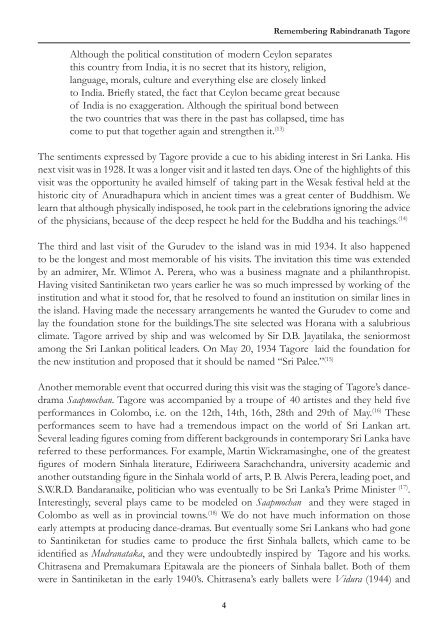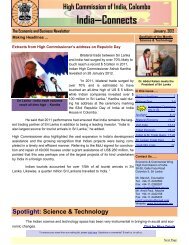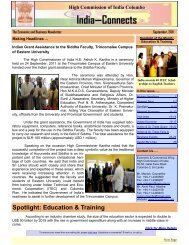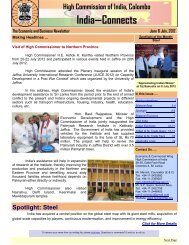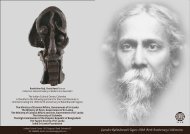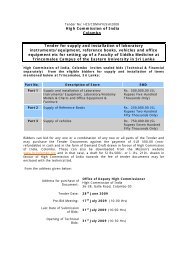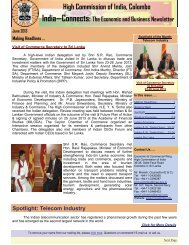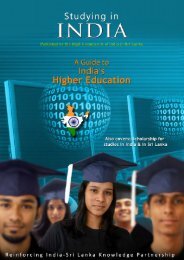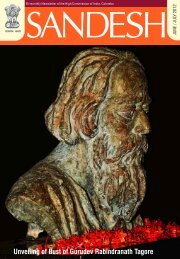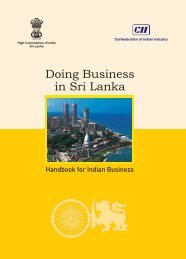Remembering Rabindranath Tagore Volume - High Commission of ...
Remembering Rabindranath Tagore Volume - High Commission of ...
Remembering Rabindranath Tagore Volume - High Commission of ...
You also want an ePaper? Increase the reach of your titles
YUMPU automatically turns print PDFs into web optimized ePapers that Google loves.
4<br />
<strong>Remembering</strong> <strong>Rabindranath</strong> <strong>Tagore</strong><br />
Although the political constitution <strong>of</strong> modern Ceylon separates<br />
this country from India, it is no secret that its history, religion,<br />
language, morals, culture and everything else are closely linked<br />
to India. Briefly stated, the fact that Ceylon became great because<br />
<strong>of</strong> India is no exaggeration. Although the spiritual bond between<br />
the two countries that was there in the past has collapsed, time has<br />
come to put that together again and strengthen it. (13)<br />
The sentiments expressed by <strong>Tagore</strong> provide a cue to his abiding interest in Sri Lanka. His<br />
next visit was in 1928. It was a longer visit and it lasted ten days. One <strong>of</strong> the highlights <strong>of</strong> this<br />
visit was the opportunity he availed himself <strong>of</strong> taking part in the Wesak festival held at the<br />
historic city <strong>of</strong> Anuradhapura which in ancient times was a great center <strong>of</strong> Buddhism. We<br />
learn that although physically indisposed, he took part in the celebrations ignoring the advice<br />
<strong>of</strong> the physicians, because <strong>of</strong> the deep respect he held for the Buddha and his teachings. (14)<br />
The third and last visit <strong>of</strong> the Gurudev to the island was in mid 1934. It also happened<br />
to be the longest and most memorable <strong>of</strong> his visits. The invitation this time was extended<br />
by an admirer, Mr. Wlimot A. Perera, who was a business magnate and a philanthropist.<br />
Having visited Santiniketan two years earlier he was so much impressed by working <strong>of</strong> the<br />
institution and what it stood for, that he resolved to found an institution on similar lines in<br />
the island. Having made the necessary arrangements he wanted the Gurudev to come and<br />
lay the foundation stone for the buildings.The site selected was Horana with a salubrious<br />
climate. <strong>Tagore</strong> arrived by ship and was welcomed by Sir D.B. Jayatilaka, the seniormost<br />
among the Sri Lankan political leaders. On May 20, 1934 <strong>Tagore</strong> laid the foundation for<br />
the new institution and proposed that it should be named “Sri Palee.” (15)<br />
Another memorable event that occurred during this visit was the staging <strong>of</strong> <strong>Tagore</strong>’s dancedrama<br />
Saapmochan. <strong>Tagore</strong> was accompanied by a troupe <strong>of</strong> 40 artistes and they held five<br />
performances in Colombo, i.e. on the 12th, 14th, 16th, 28th and 29th <strong>of</strong> May. (16) These<br />
performances seem to have had a tremendous impact on the world <strong>of</strong> Sri Lankan art.<br />
Several leading figures coming from different backgrounds in contemporary Sri Lanka have<br />
referred to these performances. For example, Martin Wickramasinghe, one <strong>of</strong> the greatest<br />
figures <strong>of</strong> modern Sinhala literature, Ediriweera Sarachchandra, university academic and<br />
another outstanding figure in the Sinhala world <strong>of</strong> arts, P. B. Alwis Perera, leading poet, and<br />
S.W.R.D. Bandaranaike, politician who was eventually to be Sri Lanka’s Prime Minister (17) .<br />
Interestingly, several plays came to be modeled on Saapmochan and they were staged in<br />
Colombo as well as in provincial towns. (18) We do not have much information on those<br />
early attempts at producing dance-dramas. But eventually some Sri Lankans who had gone<br />
to Santiniketan for studies came to produce the first Sinhala ballets, which came to be<br />
identified as Mudranataka, and they were undoubtedly inspired by <strong>Tagore</strong> and his works.<br />
Chitrasena and Premakumara Epitawala are the pioneers <strong>of</strong> Sinhala ballet. Both <strong>of</strong> them<br />
were in Santiniketan in the early 1940’s. Chitrasena’s early ballets were Vidura (1944) and


